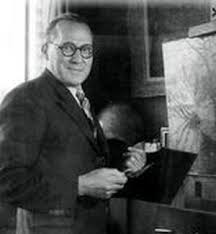(1884-1972)
Paulémile was the youngest of six children born to Camille and Julie Pissarro in 1884. Of all Camille Pissarro’s sons, Paulémile may have been the most naturally talented. Among his father’s papers (found after he died), was a very precocious drawing of a white horse done when the boy was only five. The drawing had been much praised by the French writer Mirbeau.
Paulémile entered college at the age of fifteen but left after a short time to study and travel with his father. And, unlike his brothers, Paulémile’s art education was not limited to just that of his father’s tutelage. He attended a private art academy in Paris during the winter months when his by now modestly well-off parents lived in the city. Paulémile was just nineteen when his father died in 1903.
After his father’s death, Paulémile moved with his mother to their summer home near Eragny. Eragny was a mere 30 km from Giverny, the home of his father’s closest friend and Paulémile’s Godfather, Claude Monet. As he grew older, it was to Monet that Paulémile gravitated, adopting him both as a father figure, teacher, and friend. And it was Monet, as much or more than his father, who was to influence his art as the youngest Pissarro yearned to follow in his father’s footsteps. Paulémile exhibited for the first time in the 1905 Salon des Independants. The entry was an Impressionist landscape entitled Bords de l’Epte a Eragny.
Despite his name, Paulèmile struggled and was encouraged by his mother to give up his art. For a time, he worked as an auto mechanic and test driver, later as a lace and textile designer. His work allowed him virtually no time to paint.
It was his oldest brother, Lucien, who wrote from London and asked Paulèmile to send him some early watercolors. Perhaps because of the Pissarro name, the work quickly sold to British collectors. Paulèmile quit the lace factory, married, and spent the W.W. I years painting in the north of France (illness kept from military service) and selling his work through his brother in London. The individuality and confidence he acquired during this time, along with the teachings of Monet and the strong influence of Cézanne in his work, made him immensely popular, especially in England. His older brother shepherded his career, gaining him entrance into the New English Art Club, The Allied Artists’ Association, and the Baillie Gallery, where his work sold steadily. In France, along with his close friends van Dongen, Vlaminck, de Segonzac, and Raoul Dufy, he became one of the stars of Postimpressionism. He adopted the palette knife over the brush as his preferred painting tool and, more than his father’s or even Monet’s work, his own painting began t resemble more closely that of Cézanne.
The 1920s and 1930s were to be the strongest period in Paulèmile Pissarro’s painting career. In 1930 he divorced his first wife and married a second. They purchased a home near Clecy on the Orne River in the area of hills and valleys known as Swiss Normandy. There they raised three children – two sons and a daughter. His oldest son, Hughes-Claude also became a painter. In 1967, Paulèmile Pissarro had his first one-man show in the United States at the Wally Findlay Galleries in New York, which led to wide recognition and success in this country, far in excess of that of his brothers, or even his father during his lifetime. The last of the first-generation Pissarro’s, Paulèmile died in 1972.

